Analysis of Food and Beverage Operations: Trends and Technologies
VerifiedAdded on 2021/02/21
|12
|3631
|34
Report
AI Summary
This report provides a detailed analysis of managing food and beverage operations, focusing on various aspects of the industry. It begins with an investigation into different business types within the food and beverage sector, followed by a discussion of rating systems implemented at national and international levels. The report then explores current and future trends impacting food and beverage businesses, such as technology, e-commerce, and changing customer preferences, as well as the impact of uncertainty, innovation, and mergers and acquisitions. A comparison between operational and marketing technologies is made using case studies of Arla Foods, Tyson Foods, and ConAgra Foods. The report also examines the forces influencing decision-making processes in food and beverage outlets, including pricing, dynamic environments, political factors, and competitor strategies. Finally, it discusses tactics used to build customer loyalty. The report highlights the importance of adapting to trends and leveraging technology to maintain a competitive edge in the industry.
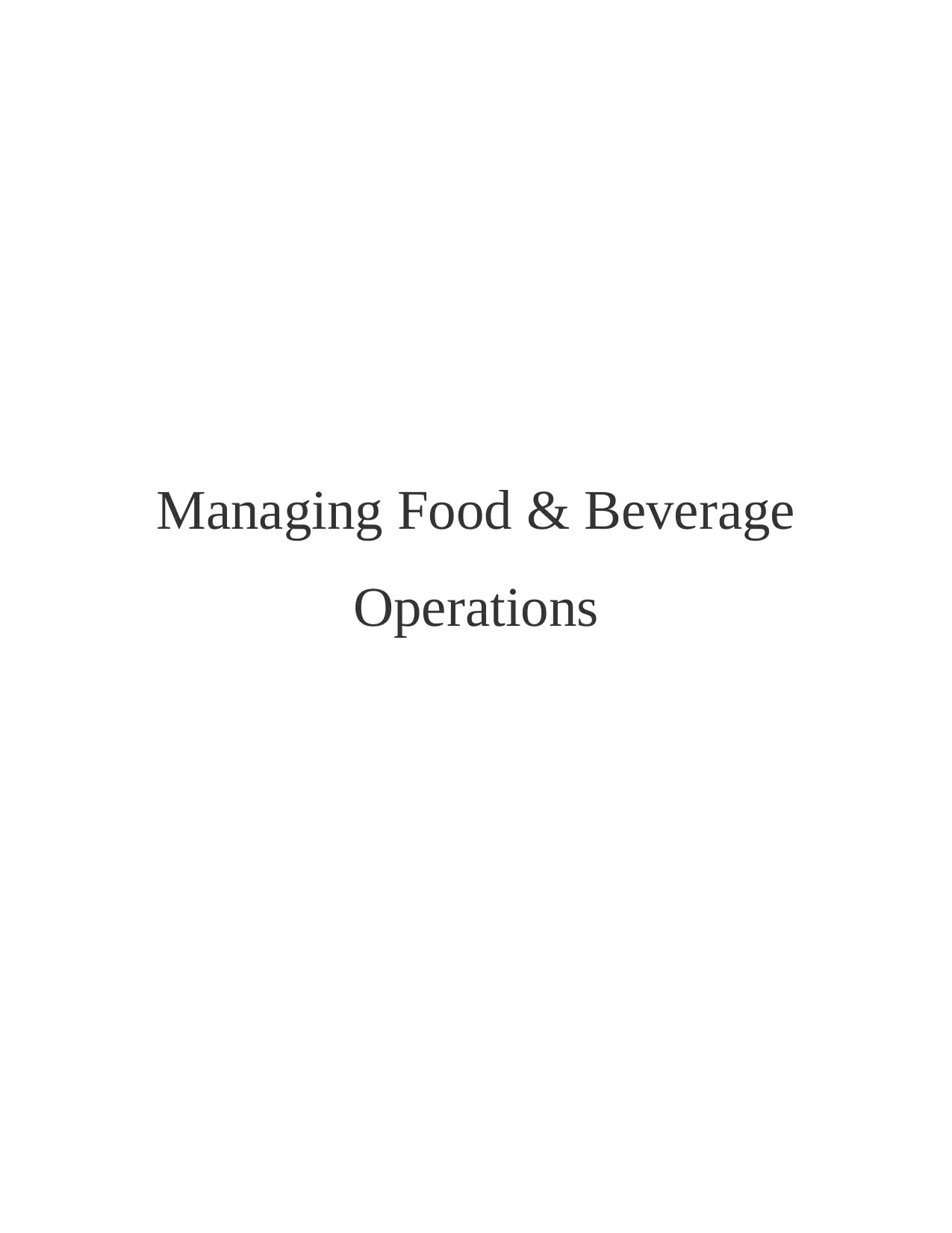
Managing Food & Beverage
Operations
Operations
Paraphrase This Document
Need a fresh take? Get an instant paraphrase of this document with our AI Paraphraser
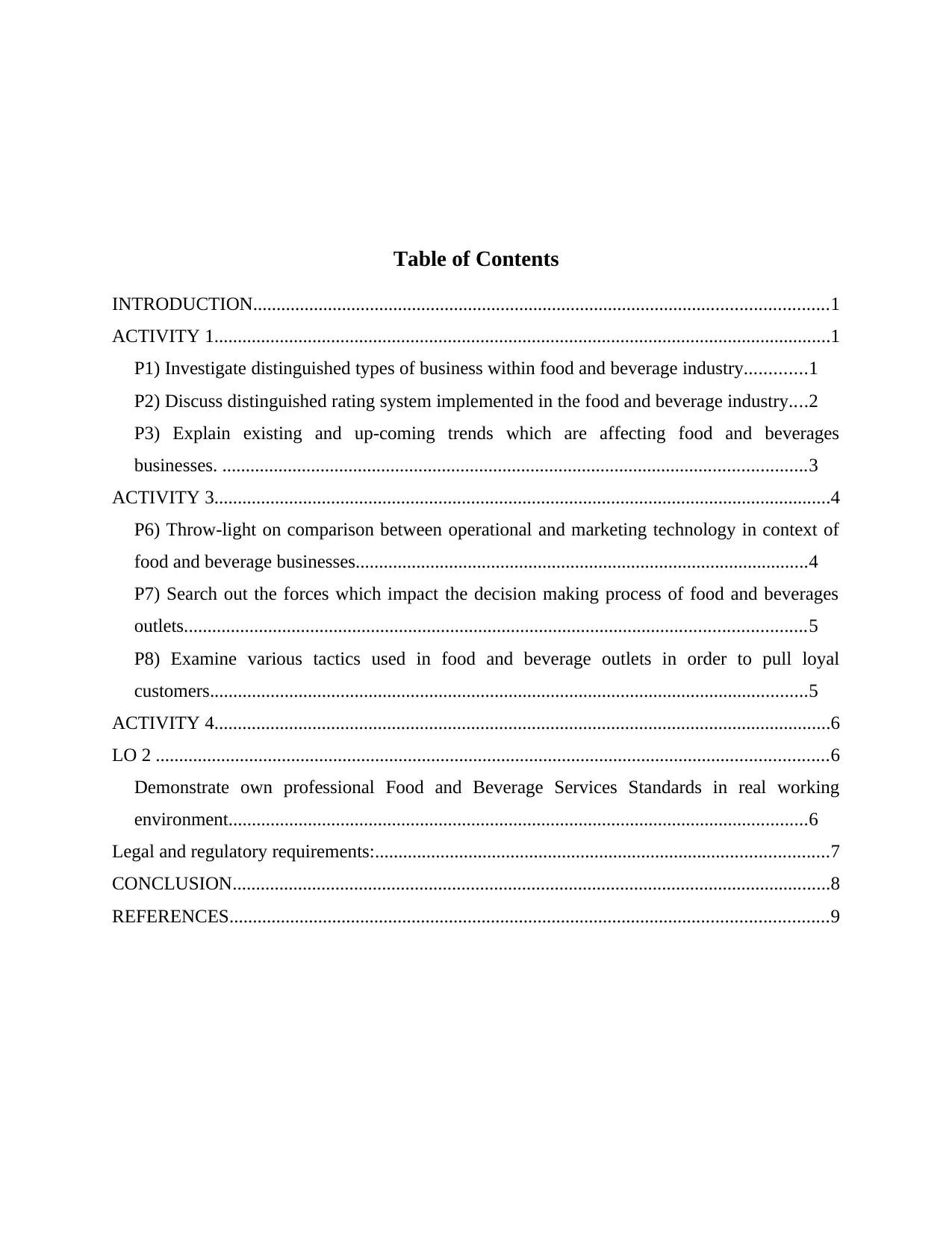
Table of Contents
INTRODUCTION...........................................................................................................................1
ACTIVITY 1....................................................................................................................................1
P1) Investigate distinguished types of business within food and beverage industry.............1
P2) Discuss distinguished rating system implemented in the food and beverage industry....2
P3) Explain existing and up-coming trends which are affecting food and beverages
businesses. .............................................................................................................................3
ACTIVITY 3....................................................................................................................................4
P6) Throw-light on comparison between operational and marketing technology in context of
food and beverage businesses.................................................................................................4
P7) Search out the forces which impact the decision making process of food and beverages
outlets.....................................................................................................................................5
P8) Examine various tactics used in food and beverage outlets in order to pull loyal
customers................................................................................................................................5
ACTIVITY 4....................................................................................................................................6
LO 2 ................................................................................................................................................6
Demonstrate own professional Food and Beverage Services Standards in real working
environment............................................................................................................................6
Legal and regulatory requirements:.................................................................................................7
CONCLUSION................................................................................................................................8
REFERENCES................................................................................................................................9
INTRODUCTION...........................................................................................................................1
ACTIVITY 1....................................................................................................................................1
P1) Investigate distinguished types of business within food and beverage industry.............1
P2) Discuss distinguished rating system implemented in the food and beverage industry....2
P3) Explain existing and up-coming trends which are affecting food and beverages
businesses. .............................................................................................................................3
ACTIVITY 3....................................................................................................................................4
P6) Throw-light on comparison between operational and marketing technology in context of
food and beverage businesses.................................................................................................4
P7) Search out the forces which impact the decision making process of food and beverages
outlets.....................................................................................................................................5
P8) Examine various tactics used in food and beverage outlets in order to pull loyal
customers................................................................................................................................5
ACTIVITY 4....................................................................................................................................6
LO 2 ................................................................................................................................................6
Demonstrate own professional Food and Beverage Services Standards in real working
environment............................................................................................................................6
Legal and regulatory requirements:.................................................................................................7
CONCLUSION................................................................................................................................8
REFERENCES................................................................................................................................9
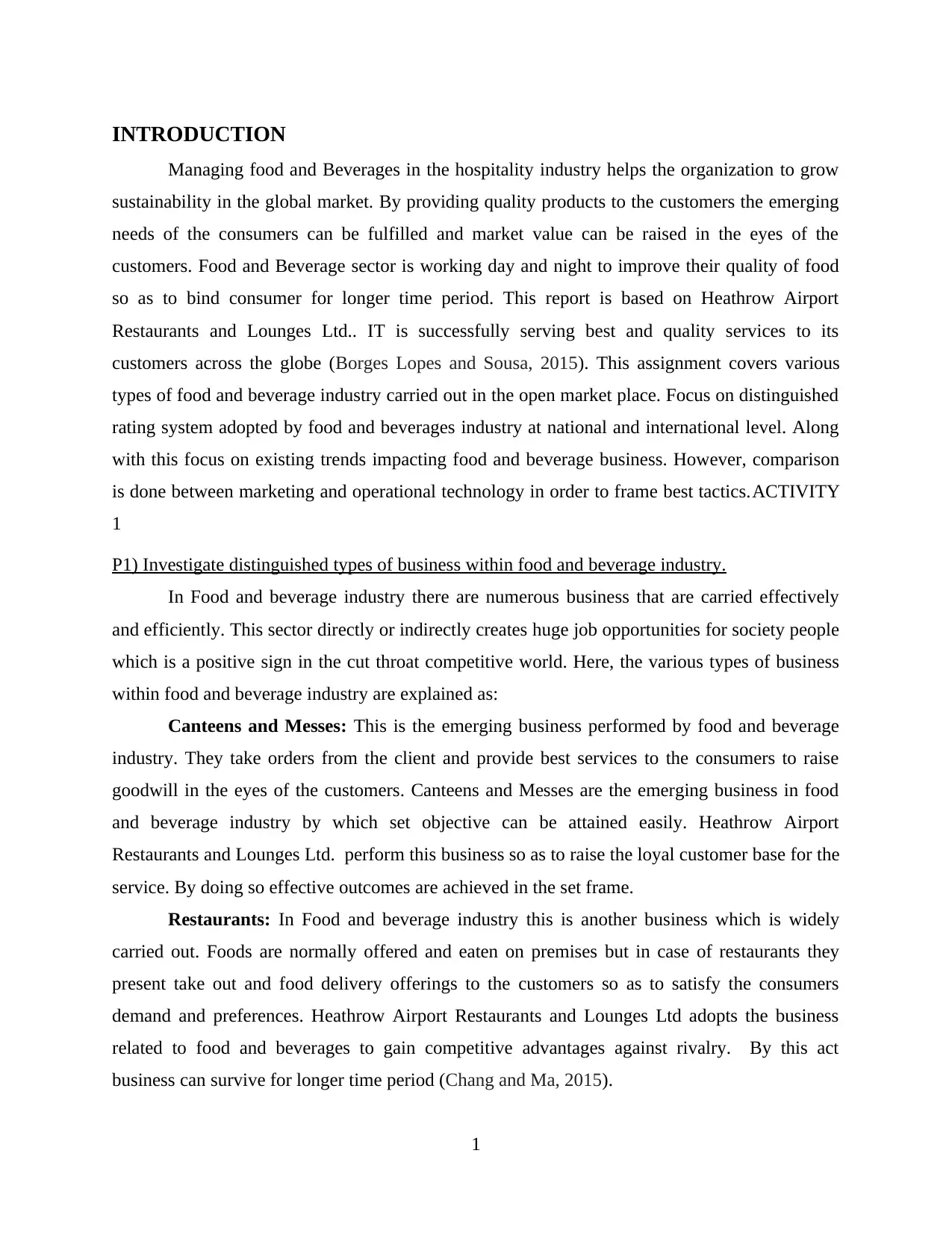
INTRODUCTION
Managing food and Beverages in the hospitality industry helps the organization to grow
sustainability in the global market. By providing quality products to the customers the emerging
needs of the consumers can be fulfilled and market value can be raised in the eyes of the
customers. Food and Beverage sector is working day and night to improve their quality of food
so as to bind consumer for longer time period. This report is based on Heathrow Airport
Restaurants and Lounges Ltd.. IT is successfully serving best and quality services to its
customers across the globe (Borges Lopes and Sousa, 2015). This assignment covers various
types of food and beverage industry carried out in the open market place. Focus on distinguished
rating system adopted by food and beverages industry at national and international level. Along
with this focus on existing trends impacting food and beverage business. However, comparison
is done between marketing and operational technology in order to frame best tactics.ACTIVITY
1
P1) Investigate distinguished types of business within food and beverage industry.
In Food and beverage industry there are numerous business that are carried effectively
and efficiently. This sector directly or indirectly creates huge job opportunities for society people
which is a positive sign in the cut throat competitive world. Here, the various types of business
within food and beverage industry are explained as:
Canteens and Messes: This is the emerging business performed by food and beverage
industry. They take orders from the client and provide best services to the consumers to raise
goodwill in the eyes of the customers. Canteens and Messes are the emerging business in food
and beverage industry by which set objective can be attained easily. Heathrow Airport
Restaurants and Lounges Ltd. perform this business so as to raise the loyal customer base for the
service. By doing so effective outcomes are achieved in the set frame.
Restaurants: In Food and beverage industry this is another business which is widely
carried out. Foods are normally offered and eaten on premises but in case of restaurants they
present take out and food delivery offerings to the customers so as to satisfy the consumers
demand and preferences. Heathrow Airport Restaurants and Lounges Ltd adopts the business
related to food and beverages to gain competitive advantages against rivalry. By this act
business can survive for longer time period (Chang and Ma, 2015).
1
Managing food and Beverages in the hospitality industry helps the organization to grow
sustainability in the global market. By providing quality products to the customers the emerging
needs of the consumers can be fulfilled and market value can be raised in the eyes of the
customers. Food and Beverage sector is working day and night to improve their quality of food
so as to bind consumer for longer time period. This report is based on Heathrow Airport
Restaurants and Lounges Ltd.. IT is successfully serving best and quality services to its
customers across the globe (Borges Lopes and Sousa, 2015). This assignment covers various
types of food and beverage industry carried out in the open market place. Focus on distinguished
rating system adopted by food and beverages industry at national and international level. Along
with this focus on existing trends impacting food and beverage business. However, comparison
is done between marketing and operational technology in order to frame best tactics.ACTIVITY
1
P1) Investigate distinguished types of business within food and beverage industry.
In Food and beverage industry there are numerous business that are carried effectively
and efficiently. This sector directly or indirectly creates huge job opportunities for society people
which is a positive sign in the cut throat competitive world. Here, the various types of business
within food and beverage industry are explained as:
Canteens and Messes: This is the emerging business performed by food and beverage
industry. They take orders from the client and provide best services to the consumers to raise
goodwill in the eyes of the customers. Canteens and Messes are the emerging business in food
and beverage industry by which set objective can be attained easily. Heathrow Airport
Restaurants and Lounges Ltd. perform this business so as to raise the loyal customer base for the
service. By doing so effective outcomes are achieved in the set frame.
Restaurants: In Food and beverage industry this is another business which is widely
carried out. Foods are normally offered and eaten on premises but in case of restaurants they
present take out and food delivery offerings to the customers so as to satisfy the consumers
demand and preferences. Heathrow Airport Restaurants and Lounges Ltd adopts the business
related to food and beverages to gain competitive advantages against rivalry. By this act
business can survive for longer time period (Chang and Ma, 2015).
1
⊘ This is a preview!⊘
Do you want full access?
Subscribe today to unlock all pages.

Trusted by 1+ million students worldwide
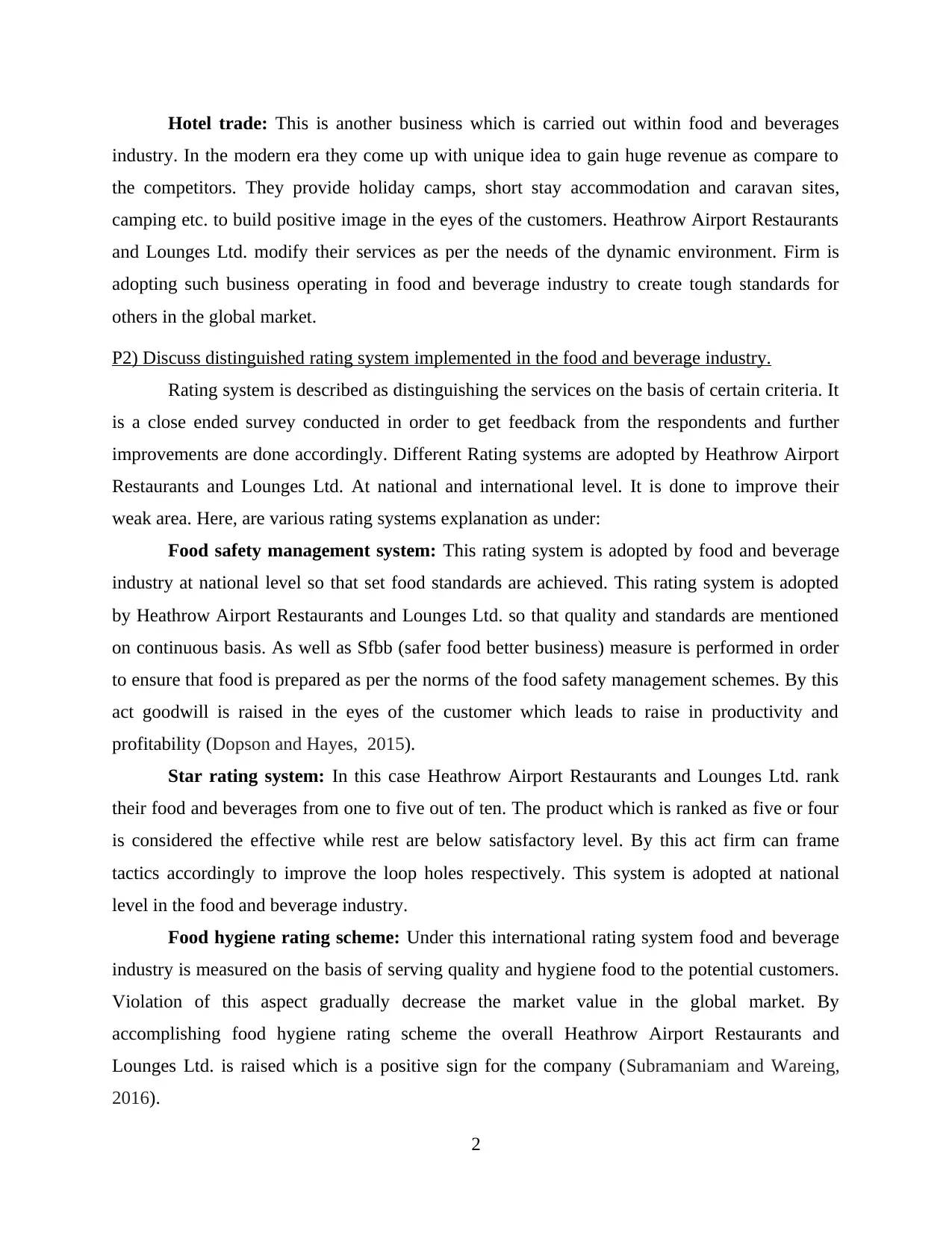
Hotel trade: This is another business which is carried out within food and beverages
industry. In the modern era they come up with unique idea to gain huge revenue as compare to
the competitors. They provide holiday camps, short stay accommodation and caravan sites,
camping etc. to build positive image in the eyes of the customers. Heathrow Airport Restaurants
and Lounges Ltd. modify their services as per the needs of the dynamic environment. Firm is
adopting such business operating in food and beverage industry to create tough standards for
others in the global market.
P2) Discuss distinguished rating system implemented in the food and beverage industry.
Rating system is described as distinguishing the services on the basis of certain criteria. It
is a close ended survey conducted in order to get feedback from the respondents and further
improvements are done accordingly. Different Rating systems are adopted by Heathrow Airport
Restaurants and Lounges Ltd. At national and international level. It is done to improve their
weak area. Here, are various rating systems explanation as under:
Food safety management system: This rating system is adopted by food and beverage
industry at national level so that set food standards are achieved. This rating system is adopted
by Heathrow Airport Restaurants and Lounges Ltd. so that quality and standards are mentioned
on continuous basis. As well as Sfbb (safer food better business) measure is performed in order
to ensure that food is prepared as per the norms of the food safety management schemes. By this
act goodwill is raised in the eyes of the customer which leads to raise in productivity and
profitability (Dopson and Hayes, 2015).
Star rating system: In this case Heathrow Airport Restaurants and Lounges Ltd. rank
their food and beverages from one to five out of ten. The product which is ranked as five or four
is considered the effective while rest are below satisfactory level. By this act firm can frame
tactics accordingly to improve the loop holes respectively. This system is adopted at national
level in the food and beverage industry.
Food hygiene rating scheme: Under this international rating system food and beverage
industry is measured on the basis of serving quality and hygiene food to the potential customers.
Violation of this aspect gradually decrease the market value in the global market. By
accomplishing food hygiene rating scheme the overall Heathrow Airport Restaurants and
Lounges Ltd. is raised which is a positive sign for the company (Subramaniam and Wareing,
2016).
2
industry. In the modern era they come up with unique idea to gain huge revenue as compare to
the competitors. They provide holiday camps, short stay accommodation and caravan sites,
camping etc. to build positive image in the eyes of the customers. Heathrow Airport Restaurants
and Lounges Ltd. modify their services as per the needs of the dynamic environment. Firm is
adopting such business operating in food and beverage industry to create tough standards for
others in the global market.
P2) Discuss distinguished rating system implemented in the food and beverage industry.
Rating system is described as distinguishing the services on the basis of certain criteria. It
is a close ended survey conducted in order to get feedback from the respondents and further
improvements are done accordingly. Different Rating systems are adopted by Heathrow Airport
Restaurants and Lounges Ltd. At national and international level. It is done to improve their
weak area. Here, are various rating systems explanation as under:
Food safety management system: This rating system is adopted by food and beverage
industry at national level so that set food standards are achieved. This rating system is adopted
by Heathrow Airport Restaurants and Lounges Ltd. so that quality and standards are mentioned
on continuous basis. As well as Sfbb (safer food better business) measure is performed in order
to ensure that food is prepared as per the norms of the food safety management schemes. By this
act goodwill is raised in the eyes of the customer which leads to raise in productivity and
profitability (Dopson and Hayes, 2015).
Star rating system: In this case Heathrow Airport Restaurants and Lounges Ltd. rank
their food and beverages from one to five out of ten. The product which is ranked as five or four
is considered the effective while rest are below satisfactory level. By this act firm can frame
tactics accordingly to improve the loop holes respectively. This system is adopted at national
level in the food and beverage industry.
Food hygiene rating scheme: Under this international rating system food and beverage
industry is measured on the basis of serving quality and hygiene food to the potential customers.
Violation of this aspect gradually decrease the market value in the global market. By
accomplishing food hygiene rating scheme the overall Heathrow Airport Restaurants and
Lounges Ltd. is raised which is a positive sign for the company (Subramaniam and Wareing,
2016).
2
Paraphrase This Document
Need a fresh take? Get an instant paraphrase of this document with our AI Paraphraser
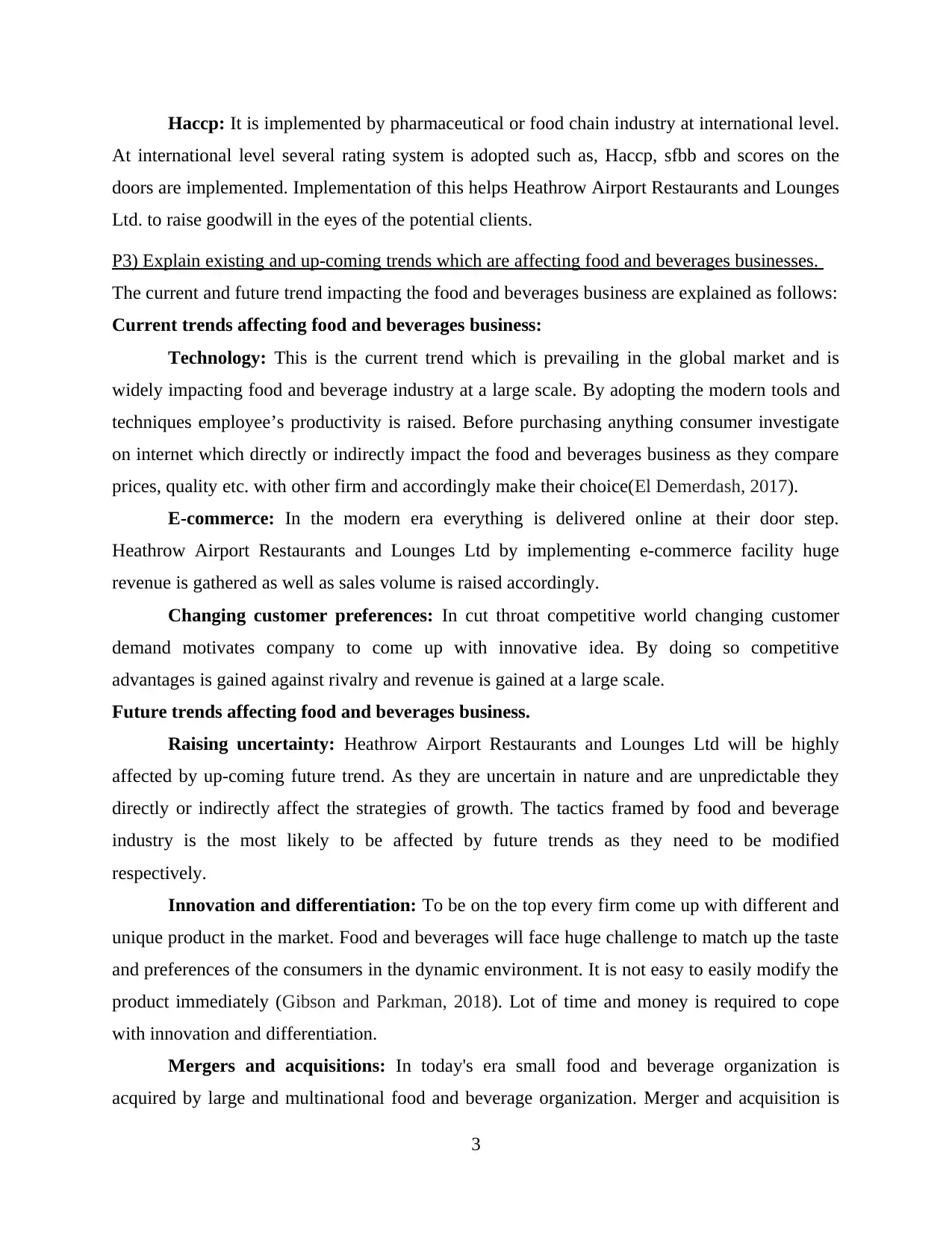
Haccp: It is implemented by pharmaceutical or food chain industry at international level.
At international level several rating system is adopted such as, Haccp, sfbb and scores on the
doors are implemented. Implementation of this helps Heathrow Airport Restaurants and Lounges
Ltd. to raise goodwill in the eyes of the potential clients.
P3) Explain existing and up-coming trends which are affecting food and beverages businesses.
The current and future trend impacting the food and beverages business are explained as follows:
Current trends affecting food and beverages business:
Technology: This is the current trend which is prevailing in the global market and is
widely impacting food and beverage industry at a large scale. By adopting the modern tools and
techniques employee’s productivity is raised. Before purchasing anything consumer investigate
on internet which directly or indirectly impact the food and beverages business as they compare
prices, quality etc. with other firm and accordingly make their choice(El Demerdash, 2017).
E-commerce: In the modern era everything is delivered online at their door step.
Heathrow Airport Restaurants and Lounges Ltd by implementing e-commerce facility huge
revenue is gathered as well as sales volume is raised accordingly.
Changing customer preferences: In cut throat competitive world changing customer
demand motivates company to come up with innovative idea. By doing so competitive
advantages is gained against rivalry and revenue is gained at a large scale.
Future trends affecting food and beverages business.
Raising uncertainty: Heathrow Airport Restaurants and Lounges Ltd will be highly
affected by up-coming future trend. As they are uncertain in nature and are unpredictable they
directly or indirectly affect the strategies of growth. The tactics framed by food and beverage
industry is the most likely to be affected by future trends as they need to be modified
respectively.
Innovation and differentiation: To be on the top every firm come up with different and
unique product in the market. Food and beverages will face huge challenge to match up the taste
and preferences of the consumers in the dynamic environment. It is not easy to easily modify the
product immediately (Gibson and Parkman, 2018). Lot of time and money is required to cope
with innovation and differentiation.
Mergers and acquisitions: In today's era small food and beverage organization is
acquired by large and multinational food and beverage organization. Merger and acquisition is
3
At international level several rating system is adopted such as, Haccp, sfbb and scores on the
doors are implemented. Implementation of this helps Heathrow Airport Restaurants and Lounges
Ltd. to raise goodwill in the eyes of the potential clients.
P3) Explain existing and up-coming trends which are affecting food and beverages businesses.
The current and future trend impacting the food and beverages business are explained as follows:
Current trends affecting food and beverages business:
Technology: This is the current trend which is prevailing in the global market and is
widely impacting food and beverage industry at a large scale. By adopting the modern tools and
techniques employee’s productivity is raised. Before purchasing anything consumer investigate
on internet which directly or indirectly impact the food and beverages business as they compare
prices, quality etc. with other firm and accordingly make their choice(El Demerdash, 2017).
E-commerce: In the modern era everything is delivered online at their door step.
Heathrow Airport Restaurants and Lounges Ltd by implementing e-commerce facility huge
revenue is gathered as well as sales volume is raised accordingly.
Changing customer preferences: In cut throat competitive world changing customer
demand motivates company to come up with innovative idea. By doing so competitive
advantages is gained against rivalry and revenue is gained at a large scale.
Future trends affecting food and beverages business.
Raising uncertainty: Heathrow Airport Restaurants and Lounges Ltd will be highly
affected by up-coming future trend. As they are uncertain in nature and are unpredictable they
directly or indirectly affect the strategies of growth. The tactics framed by food and beverage
industry is the most likely to be affected by future trends as they need to be modified
respectively.
Innovation and differentiation: To be on the top every firm come up with different and
unique product in the market. Food and beverages will face huge challenge to match up the taste
and preferences of the consumers in the dynamic environment. It is not easy to easily modify the
product immediately (Gibson and Parkman, 2018). Lot of time and money is required to cope
with innovation and differentiation.
Mergers and acquisitions: In today's era small food and beverage organization is
acquired by large and multinational food and beverage organization. Merger and acquisition is
3
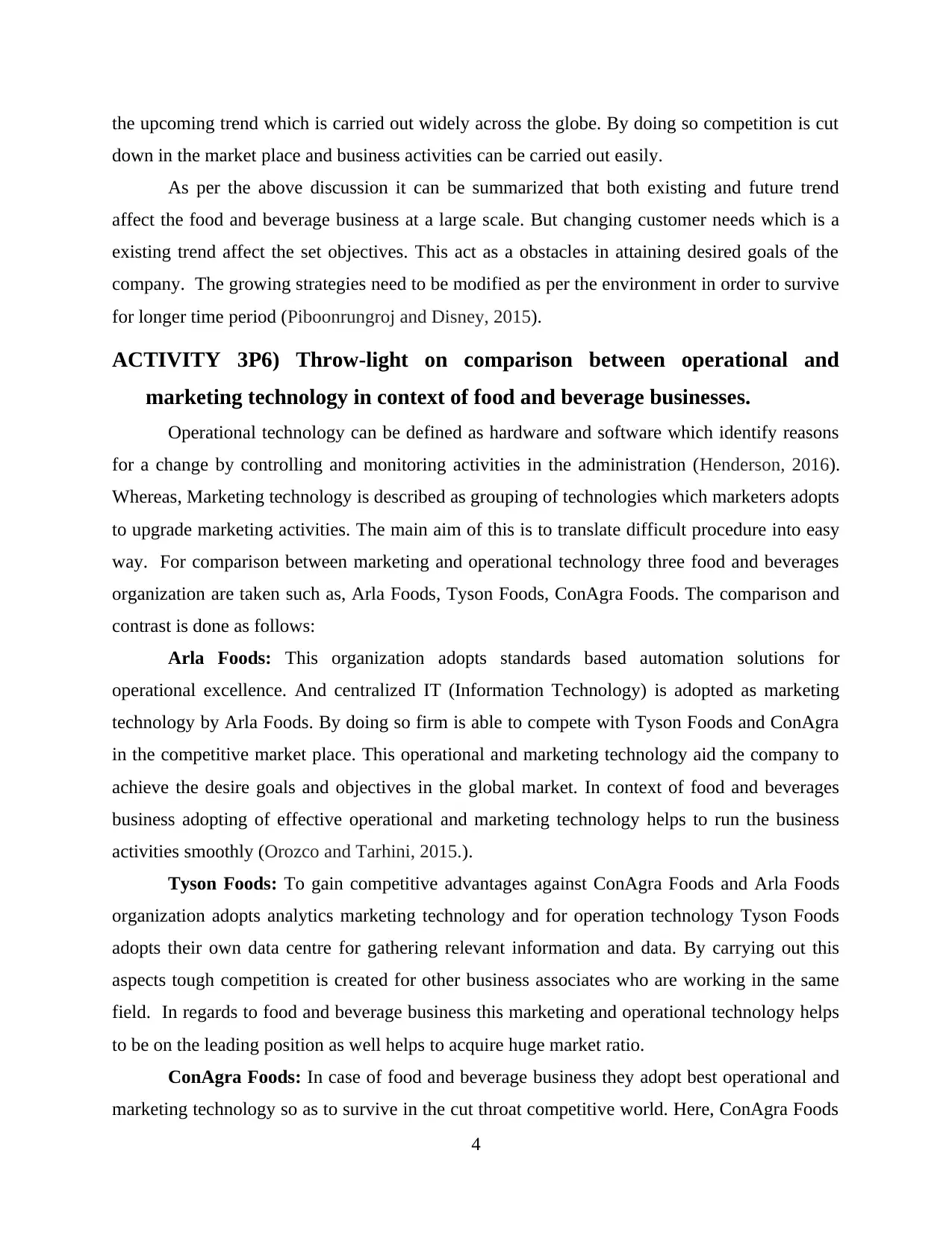
the upcoming trend which is carried out widely across the globe. By doing so competition is cut
down in the market place and business activities can be carried out easily.
As per the above discussion it can be summarized that both existing and future trend
affect the food and beverage business at a large scale. But changing customer needs which is a
existing trend affect the set objectives. This act as a obstacles in attaining desired goals of the
company. The growing strategies need to be modified as per the environment in order to survive
for longer time period (Piboonrungroj and Disney, 2015).
ACTIVITY 3P6) Throw-light on comparison between operational and
marketing technology in context of food and beverage businesses.
Operational technology can be defined as hardware and software which identify reasons
for a change by controlling and monitoring activities in the administration (Henderson, 2016).
Whereas, Marketing technology is described as grouping of technologies which marketers adopts
to upgrade marketing activities. The main aim of this is to translate difficult procedure into easy
way. For comparison between marketing and operational technology three food and beverages
organization are taken such as, Arla Foods, Tyson Foods, ConAgra Foods. The comparison and
contrast is done as follows:
Arla Foods: This organization adopts standards based automation solutions for
operational excellence. And centralized IT (Information Technology) is adopted as marketing
technology by Arla Foods. By doing so firm is able to compete with Tyson Foods and ConAgra
in the competitive market place. This operational and marketing technology aid the company to
achieve the desire goals and objectives in the global market. In context of food and beverages
business adopting of effective operational and marketing technology helps to run the business
activities smoothly (Orozco and Tarhini, 2015.).
Tyson Foods: To gain competitive advantages against ConAgra Foods and Arla Foods
organization adopts analytics marketing technology and for operation technology Tyson Foods
adopts their own data centre for gathering relevant information and data. By carrying out this
aspects tough competition is created for other business associates who are working in the same
field. In regards to food and beverage business this marketing and operational technology helps
to be on the leading position as well helps to acquire huge market ratio.
ConAgra Foods: In case of food and beverage business they adopt best operational and
marketing technology so as to survive in the cut throat competitive world. Here, ConAgra Foods
4
down in the market place and business activities can be carried out easily.
As per the above discussion it can be summarized that both existing and future trend
affect the food and beverage business at a large scale. But changing customer needs which is a
existing trend affect the set objectives. This act as a obstacles in attaining desired goals of the
company. The growing strategies need to be modified as per the environment in order to survive
for longer time period (Piboonrungroj and Disney, 2015).
ACTIVITY 3P6) Throw-light on comparison between operational and
marketing technology in context of food and beverage businesses.
Operational technology can be defined as hardware and software which identify reasons
for a change by controlling and monitoring activities in the administration (Henderson, 2016).
Whereas, Marketing technology is described as grouping of technologies which marketers adopts
to upgrade marketing activities. The main aim of this is to translate difficult procedure into easy
way. For comparison between marketing and operational technology three food and beverages
organization are taken such as, Arla Foods, Tyson Foods, ConAgra Foods. The comparison and
contrast is done as follows:
Arla Foods: This organization adopts standards based automation solutions for
operational excellence. And centralized IT (Information Technology) is adopted as marketing
technology by Arla Foods. By doing so firm is able to compete with Tyson Foods and ConAgra
in the competitive market place. This operational and marketing technology aid the company to
achieve the desire goals and objectives in the global market. In context of food and beverages
business adopting of effective operational and marketing technology helps to run the business
activities smoothly (Orozco and Tarhini, 2015.).
Tyson Foods: To gain competitive advantages against ConAgra Foods and Arla Foods
organization adopts analytics marketing technology and for operation technology Tyson Foods
adopts their own data centre for gathering relevant information and data. By carrying out this
aspects tough competition is created for other business associates who are working in the same
field. In regards to food and beverage business this marketing and operational technology helps
to be on the leading position as well helps to acquire huge market ratio.
ConAgra Foods: In case of food and beverage business they adopt best operational and
marketing technology so as to survive in the cut throat competitive world. Here, ConAgra Foods
4
⊘ This is a preview!⊘
Do you want full access?
Subscribe today to unlock all pages.

Trusted by 1+ million students worldwide
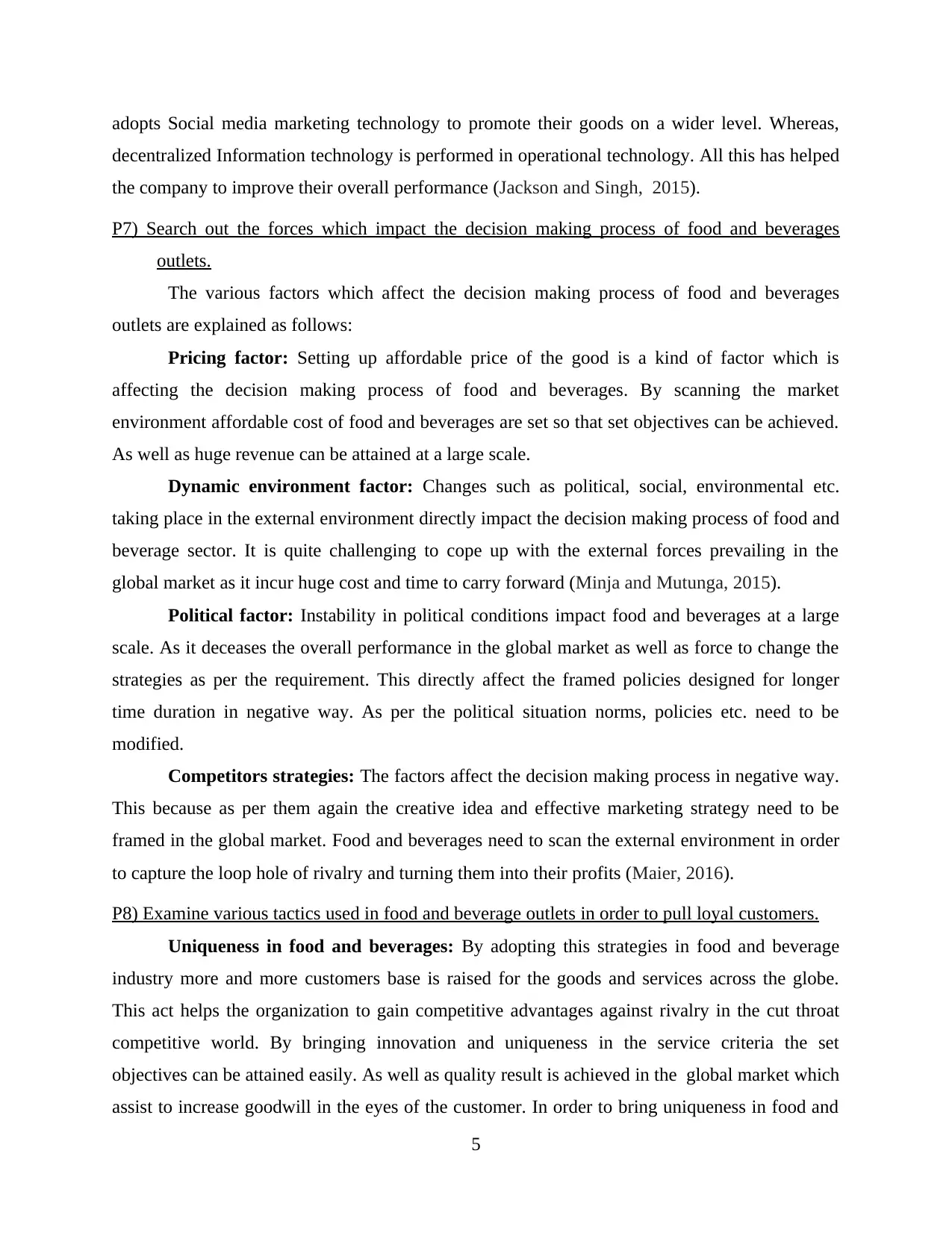
adopts Social media marketing technology to promote their goods on a wider level. Whereas,
decentralized Information technology is performed in operational technology. All this has helped
the company to improve their overall performance (Jackson and Singh, 2015).
P7) Search out the forces which impact the decision making process of food and beverages
outlets.
The various factors which affect the decision making process of food and beverages
outlets are explained as follows:
Pricing factor: Setting up affordable price of the good is a kind of factor which is
affecting the decision making process of food and beverages. By scanning the market
environment affordable cost of food and beverages are set so that set objectives can be achieved.
As well as huge revenue can be attained at a large scale.
Dynamic environment factor: Changes such as political, social, environmental etc.
taking place in the external environment directly impact the decision making process of food and
beverage sector. It is quite challenging to cope up with the external forces prevailing in the
global market as it incur huge cost and time to carry forward (Minja and Mutunga, 2015).
Political factor: Instability in political conditions impact food and beverages at a large
scale. As it deceases the overall performance in the global market as well as force to change the
strategies as per the requirement. This directly affect the framed policies designed for longer
time duration in negative way. As per the political situation norms, policies etc. need to be
modified.
Competitors strategies: The factors affect the decision making process in negative way.
This because as per them again the creative idea and effective marketing strategy need to be
framed in the global market. Food and beverages need to scan the external environment in order
to capture the loop hole of rivalry and turning them into their profits (Maier, 2016).
P8) Examine various tactics used in food and beverage outlets in order to pull loyal customers.
Uniqueness in food and beverages: By adopting this strategies in food and beverage
industry more and more customers base is raised for the goods and services across the globe.
This act helps the organization to gain competitive advantages against rivalry in the cut throat
competitive world. By bringing innovation and uniqueness in the service criteria the set
objectives can be attained easily. As well as quality result is achieved in the global market which
assist to increase goodwill in the eyes of the customer. In order to bring uniqueness in food and
5
decentralized Information technology is performed in operational technology. All this has helped
the company to improve their overall performance (Jackson and Singh, 2015).
P7) Search out the forces which impact the decision making process of food and beverages
outlets.
The various factors which affect the decision making process of food and beverages
outlets are explained as follows:
Pricing factor: Setting up affordable price of the good is a kind of factor which is
affecting the decision making process of food and beverages. By scanning the market
environment affordable cost of food and beverages are set so that set objectives can be achieved.
As well as huge revenue can be attained at a large scale.
Dynamic environment factor: Changes such as political, social, environmental etc.
taking place in the external environment directly impact the decision making process of food and
beverage sector. It is quite challenging to cope up with the external forces prevailing in the
global market as it incur huge cost and time to carry forward (Minja and Mutunga, 2015).
Political factor: Instability in political conditions impact food and beverages at a large
scale. As it deceases the overall performance in the global market as well as force to change the
strategies as per the requirement. This directly affect the framed policies designed for longer
time duration in negative way. As per the political situation norms, policies etc. need to be
modified.
Competitors strategies: The factors affect the decision making process in negative way.
This because as per them again the creative idea and effective marketing strategy need to be
framed in the global market. Food and beverages need to scan the external environment in order
to capture the loop hole of rivalry and turning them into their profits (Maier, 2016).
P8) Examine various tactics used in food and beverage outlets in order to pull loyal customers.
Uniqueness in food and beverages: By adopting this strategies in food and beverage
industry more and more customers base is raised for the goods and services across the globe.
This act helps the organization to gain competitive advantages against rivalry in the cut throat
competitive world. By bringing innovation and uniqueness in the service criteria the set
objectives can be attained easily. As well as quality result is achieved in the global market which
assist to increase goodwill in the eyes of the customer. In order to bring uniqueness in food and
5
Paraphrase This Document
Need a fresh take? Get an instant paraphrase of this document with our AI Paraphraser
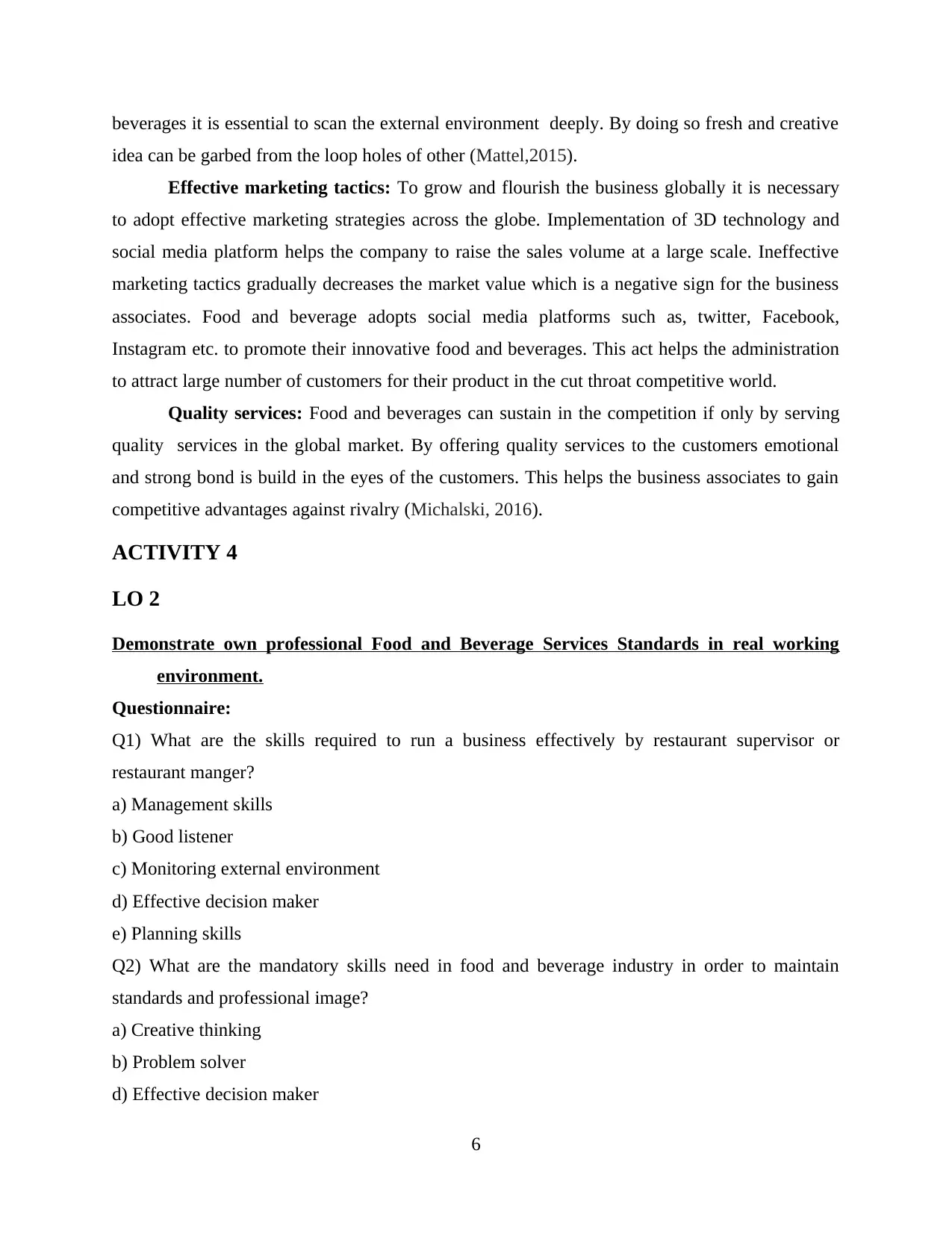
beverages it is essential to scan the external environment deeply. By doing so fresh and creative
idea can be garbed from the loop holes of other (Mattel,2015).
Effective marketing tactics: To grow and flourish the business globally it is necessary
to adopt effective marketing strategies across the globe. Implementation of 3D technology and
social media platform helps the company to raise the sales volume at a large scale. Ineffective
marketing tactics gradually decreases the market value which is a negative sign for the business
associates. Food and beverage adopts social media platforms such as, twitter, Facebook,
Instagram etc. to promote their innovative food and beverages. This act helps the administration
to attract large number of customers for their product in the cut throat competitive world.
Quality services: Food and beverages can sustain in the competition if only by serving
quality services in the global market. By offering quality services to the customers emotional
and strong bond is build in the eyes of the customers. This helps the business associates to gain
competitive advantages against rivalry (Michalski, 2016).
ACTIVITY 4
LO 2
Demonstrate own professional Food and Beverage Services Standards in real working
environment.
Questionnaire:
Q1) What are the skills required to run a business effectively by restaurant supervisor or
restaurant manger?
a) Management skills
b) Good listener
c) Monitoring external environment
d) Effective decision maker
e) Planning skills
Q2) What are the mandatory skills need in food and beverage industry in order to maintain
standards and professional image?
a) Creative thinking
b) Problem solver
d) Effective decision maker
6
idea can be garbed from the loop holes of other (Mattel,2015).
Effective marketing tactics: To grow and flourish the business globally it is necessary
to adopt effective marketing strategies across the globe. Implementation of 3D technology and
social media platform helps the company to raise the sales volume at a large scale. Ineffective
marketing tactics gradually decreases the market value which is a negative sign for the business
associates. Food and beverage adopts social media platforms such as, twitter, Facebook,
Instagram etc. to promote their innovative food and beverages. This act helps the administration
to attract large number of customers for their product in the cut throat competitive world.
Quality services: Food and beverages can sustain in the competition if only by serving
quality services in the global market. By offering quality services to the customers emotional
and strong bond is build in the eyes of the customers. This helps the business associates to gain
competitive advantages against rivalry (Michalski, 2016).
ACTIVITY 4
LO 2
Demonstrate own professional Food and Beverage Services Standards in real working
environment.
Questionnaire:
Q1) What are the skills required to run a business effectively by restaurant supervisor or
restaurant manger?
a) Management skills
b) Good listener
c) Monitoring external environment
d) Effective decision maker
e) Planning skills
Q2) What are the mandatory skills need in food and beverage industry in order to maintain
standards and professional image?
a) Creative thinking
b) Problem solver
d) Effective decision maker
6
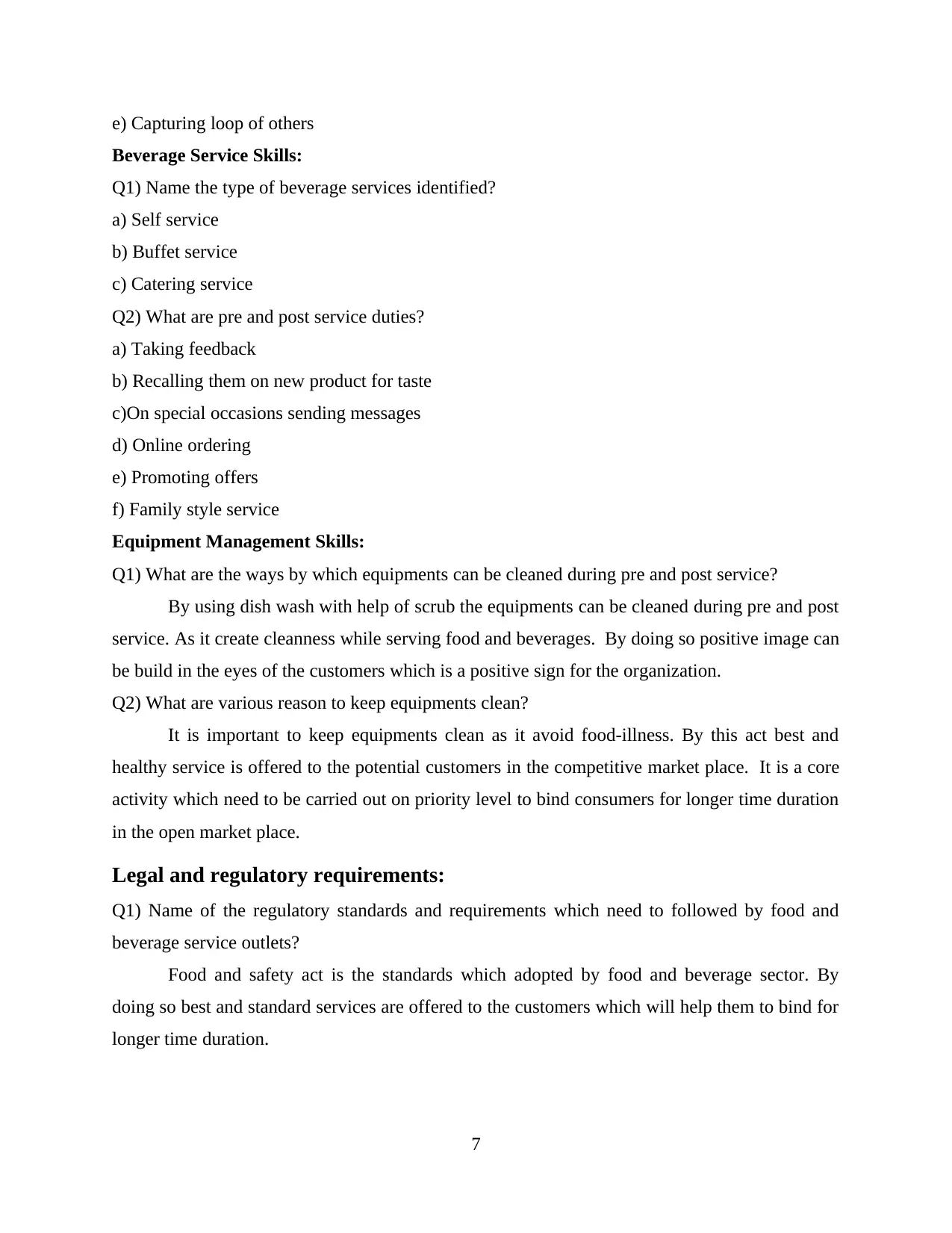
e) Capturing loop of others
Beverage Service Skills:
Q1) Name the type of beverage services identified?
a) Self service
b) Buffet service
c) Catering service
Q2) What are pre and post service duties?
a) Taking feedback
b) Recalling them on new product for taste
c)On special occasions sending messages
d) Online ordering
e) Promoting offers
f) Family style service
Equipment Management Skills:
Q1) What are the ways by which equipments can be cleaned during pre and post service?
By using dish wash with help of scrub the equipments can be cleaned during pre and post
service. As it create cleanness while serving food and beverages. By doing so positive image can
be build in the eyes of the customers which is a positive sign for the organization.
Q2) What are various reason to keep equipments clean?
It is important to keep equipments clean as it avoid food-illness. By this act best and
healthy service is offered to the potential customers in the competitive market place. It is a core
activity which need to be carried out on priority level to bind consumers for longer time duration
in the open market place.
Legal and regulatory requirements:
Q1) Name of the regulatory standards and requirements which need to followed by food and
beverage service outlets?
Food and safety act is the standards which adopted by food and beverage sector. By
doing so best and standard services are offered to the customers which will help them to bind for
longer time duration.
7
Beverage Service Skills:
Q1) Name the type of beverage services identified?
a) Self service
b) Buffet service
c) Catering service
Q2) What are pre and post service duties?
a) Taking feedback
b) Recalling them on new product for taste
c)On special occasions sending messages
d) Online ordering
e) Promoting offers
f) Family style service
Equipment Management Skills:
Q1) What are the ways by which equipments can be cleaned during pre and post service?
By using dish wash with help of scrub the equipments can be cleaned during pre and post
service. As it create cleanness while serving food and beverages. By doing so positive image can
be build in the eyes of the customers which is a positive sign for the organization.
Q2) What are various reason to keep equipments clean?
It is important to keep equipments clean as it avoid food-illness. By this act best and
healthy service is offered to the potential customers in the competitive market place. It is a core
activity which need to be carried out on priority level to bind consumers for longer time duration
in the open market place.
Legal and regulatory requirements:
Q1) Name of the regulatory standards and requirements which need to followed by food and
beverage service outlets?
Food and safety act is the standards which adopted by food and beverage sector. By
doing so best and standard services are offered to the customers which will help them to bind for
longer time duration.
7
⊘ This is a preview!⊘
Do you want full access?
Subscribe today to unlock all pages.

Trusted by 1+ million students worldwide
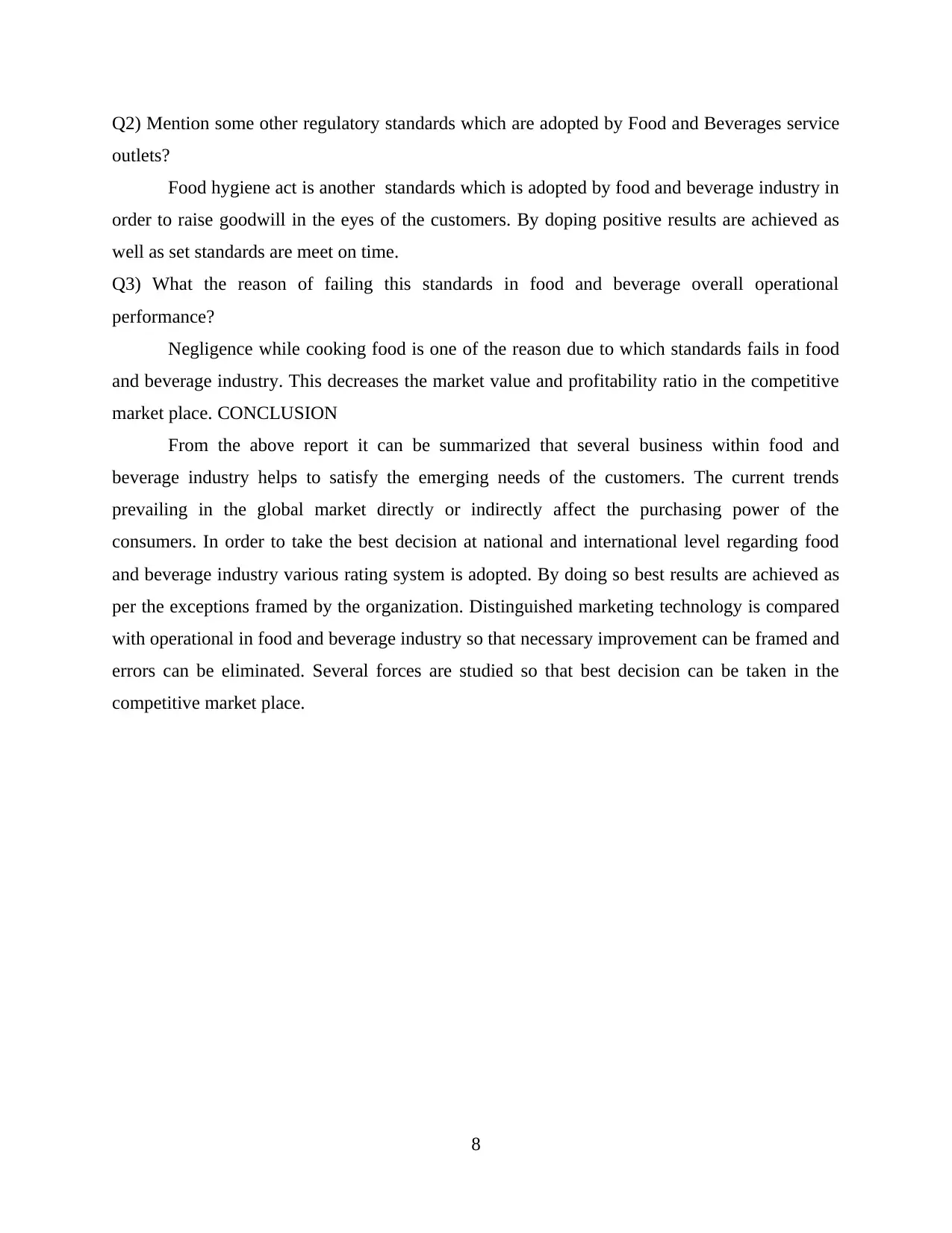
Q2) Mention some other regulatory standards which are adopted by Food and Beverages service
outlets?
Food hygiene act is another standards which is adopted by food and beverage industry in
order to raise goodwill in the eyes of the customers. By doping positive results are achieved as
well as set standards are meet on time.
Q3) What the reason of failing this standards in food and beverage overall operational
performance?
Negligence while cooking food is one of the reason due to which standards fails in food
and beverage industry. This decreases the market value and profitability ratio in the competitive
market place. CONCLUSION
From the above report it can be summarized that several business within food and
beverage industry helps to satisfy the emerging needs of the customers. The current trends
prevailing in the global market directly or indirectly affect the purchasing power of the
consumers. In order to take the best decision at national and international level regarding food
and beverage industry various rating system is adopted. By doing so best results are achieved as
per the exceptions framed by the organization. Distinguished marketing technology is compared
with operational in food and beverage industry so that necessary improvement can be framed and
errors can be eliminated. Several forces are studied so that best decision can be taken in the
competitive market place.
8
outlets?
Food hygiene act is another standards which is adopted by food and beverage industry in
order to raise goodwill in the eyes of the customers. By doping positive results are achieved as
well as set standards are meet on time.
Q3) What the reason of failing this standards in food and beverage overall operational
performance?
Negligence while cooking food is one of the reason due to which standards fails in food
and beverage industry. This decreases the market value and profitability ratio in the competitive
market place. CONCLUSION
From the above report it can be summarized that several business within food and
beverage industry helps to satisfy the emerging needs of the customers. The current trends
prevailing in the global market directly or indirectly affect the purchasing power of the
consumers. In order to take the best decision at national and international level regarding food
and beverage industry various rating system is adopted. By doing so best results are achieved as
per the exceptions framed by the organization. Distinguished marketing technology is compared
with operational in food and beverage industry so that necessary improvement can be framed and
errors can be eliminated. Several forces are studied so that best decision can be taken in the
competitive market place.
8
Paraphrase This Document
Need a fresh take? Get an instant paraphrase of this document with our AI Paraphraser
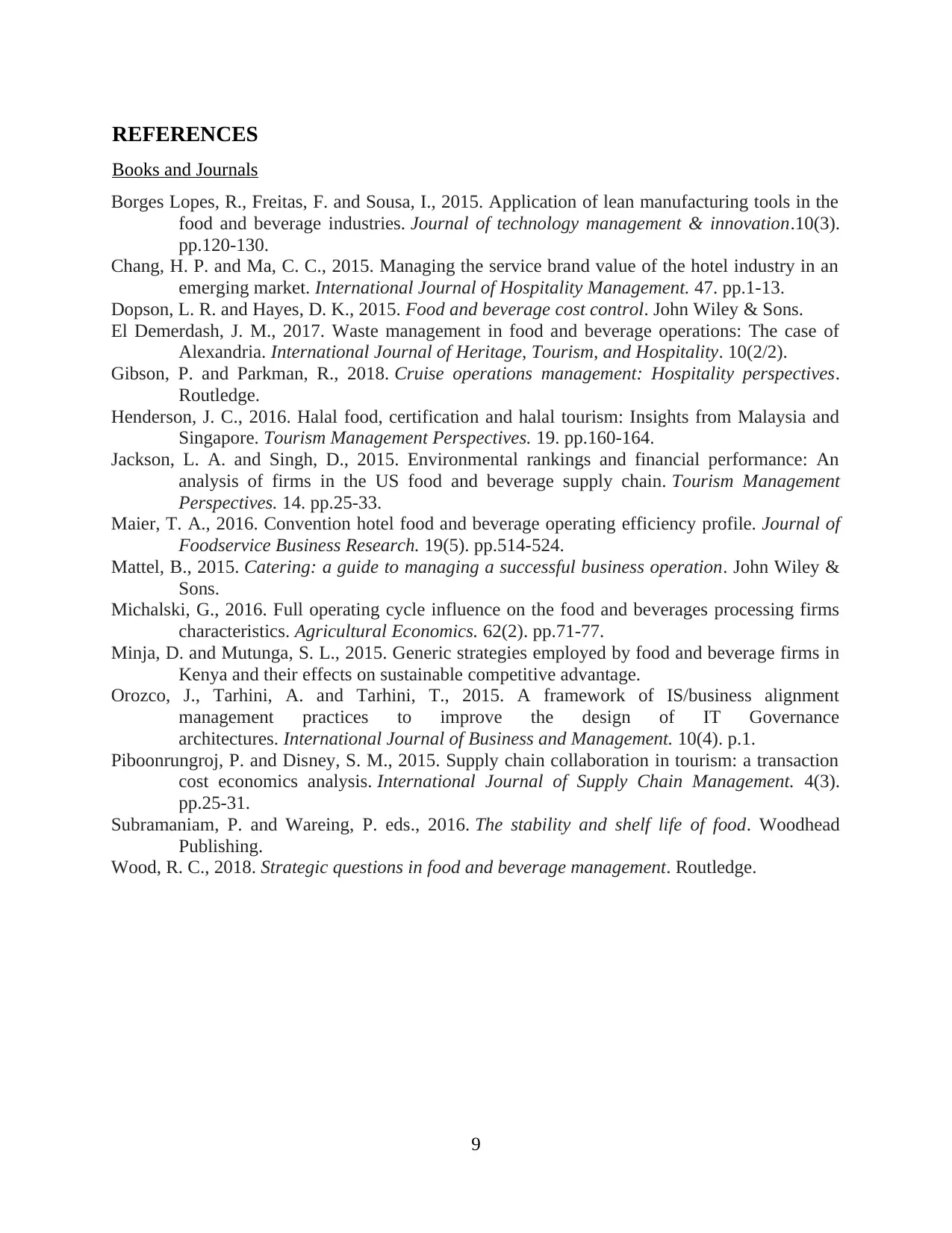
REFERENCES
Books and Journals
Borges Lopes, R., Freitas, F. and Sousa, I., 2015. Application of lean manufacturing tools in the
food and beverage industries. Journal of technology management & innovation.10(3).
pp.120-130.
Chang, H. P. and Ma, C. C., 2015. Managing the service brand value of the hotel industry in an
emerging market. International Journal of Hospitality Management. 47. pp.1-13.
Dopson, L. R. and Hayes, D. K., 2015. Food and beverage cost control. John Wiley & Sons.
El Demerdash, J. M., 2017. Waste management in food and beverage operations: The case of
Alexandria. International Journal of Heritage, Tourism, and Hospitality. 10(2/2).
Gibson, P. and Parkman, R., 2018. Cruise operations management: Hospitality perspectives.
Routledge.
Henderson, J. C., 2016. Halal food, certification and halal tourism: Insights from Malaysia and
Singapore. Tourism Management Perspectives. 19. pp.160-164.
Jackson, L. A. and Singh, D., 2015. Environmental rankings and financial performance: An
analysis of firms in the US food and beverage supply chain. Tourism Management
Perspectives. 14. pp.25-33.
Maier, T. A., 2016. Convention hotel food and beverage operating efficiency profile. Journal of
Foodservice Business Research. 19(5). pp.514-524.
Mattel, B., 2015. Catering: a guide to managing a successful business operation. John Wiley &
Sons.
Michalski, G., 2016. Full operating cycle influence on the food and beverages processing firms
characteristics. Agricultural Economics. 62(2). pp.71-77.
Minja, D. and Mutunga, S. L., 2015. Generic strategies employed by food and beverage firms in
Kenya and their effects on sustainable competitive advantage.
Orozco, J., Tarhini, A. and Tarhini, T., 2015. A framework of IS/business alignment
management practices to improve the design of IT Governance
architectures. International Journal of Business and Management. 10(4). p.1.
Piboonrungroj, P. and Disney, S. M., 2015. Supply chain collaboration in tourism: a transaction
cost economics analysis. International Journal of Supply Chain Management. 4(3).
pp.25-31.
Subramaniam, P. and Wareing, P. eds., 2016. The stability and shelf life of food. Woodhead
Publishing.
Wood, R. C., 2018. Strategic questions in food and beverage management. Routledge.
9
Books and Journals
Borges Lopes, R., Freitas, F. and Sousa, I., 2015. Application of lean manufacturing tools in the
food and beverage industries. Journal of technology management & innovation.10(3).
pp.120-130.
Chang, H. P. and Ma, C. C., 2015. Managing the service brand value of the hotel industry in an
emerging market. International Journal of Hospitality Management. 47. pp.1-13.
Dopson, L. R. and Hayes, D. K., 2015. Food and beverage cost control. John Wiley & Sons.
El Demerdash, J. M., 2017. Waste management in food and beverage operations: The case of
Alexandria. International Journal of Heritage, Tourism, and Hospitality. 10(2/2).
Gibson, P. and Parkman, R., 2018. Cruise operations management: Hospitality perspectives.
Routledge.
Henderson, J. C., 2016. Halal food, certification and halal tourism: Insights from Malaysia and
Singapore. Tourism Management Perspectives. 19. pp.160-164.
Jackson, L. A. and Singh, D., 2015. Environmental rankings and financial performance: An
analysis of firms in the US food and beverage supply chain. Tourism Management
Perspectives. 14. pp.25-33.
Maier, T. A., 2016. Convention hotel food and beverage operating efficiency profile. Journal of
Foodservice Business Research. 19(5). pp.514-524.
Mattel, B., 2015. Catering: a guide to managing a successful business operation. John Wiley &
Sons.
Michalski, G., 2016. Full operating cycle influence on the food and beverages processing firms
characteristics. Agricultural Economics. 62(2). pp.71-77.
Minja, D. and Mutunga, S. L., 2015. Generic strategies employed by food and beverage firms in
Kenya and their effects on sustainable competitive advantage.
Orozco, J., Tarhini, A. and Tarhini, T., 2015. A framework of IS/business alignment
management practices to improve the design of IT Governance
architectures. International Journal of Business and Management. 10(4). p.1.
Piboonrungroj, P. and Disney, S. M., 2015. Supply chain collaboration in tourism: a transaction
cost economics analysis. International Journal of Supply Chain Management. 4(3).
pp.25-31.
Subramaniam, P. and Wareing, P. eds., 2016. The stability and shelf life of food. Woodhead
Publishing.
Wood, R. C., 2018. Strategic questions in food and beverage management. Routledge.
9

10
⊘ This is a preview!⊘
Do you want full access?
Subscribe today to unlock all pages.

Trusted by 1+ million students worldwide
1 out of 12
Related Documents
Your All-in-One AI-Powered Toolkit for Academic Success.
+13062052269
info@desklib.com
Available 24*7 on WhatsApp / Email
![[object Object]](/_next/static/media/star-bottom.7253800d.svg)
Unlock your academic potential
Copyright © 2020–2025 A2Z Services. All Rights Reserved. Developed and managed by ZUCOL.





